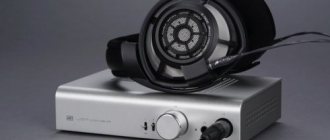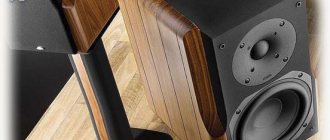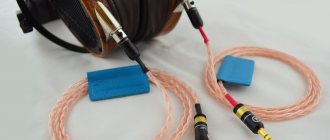When buying headphones, you can find an abundance of technical information on the packaging and in the device passport. Frequency range, as well as the number of mW, resistance and other details. Those who want to find the best headphones, focusing on the technical characteristics of the device, should understand in detail the essence of these parameters. How does headphone impedance affect your audio experience? What is impedance in headphones, and which is better?
It is impossible to definitively answer the question of which resistance is better. The ideal resistance depends on the type of device you will be using it with.
What does impedance mean?
What is impedance? Headphone impedance is resistance. But not the resistance that is most often indicated on packaging and product pages under the appropriate name. Headphone manufacturers, when distributing their products, usually indicate the active resistance of the headset in their documents. Active resistance is also called “resistive”. An indication of the impedance of a device can sometimes be difficult to find.
The combination of reactive and active gives total resistance. It's called "impedance". The output voltage appears when the current flowing through the device meets the resistance of the headphones. When the interaction of current and voltage occurs, we can talk about the power of the device.
What does resistance affect? Total resistance, or impedance, determines the sensitivity of the headphones. The lower the resistance, the higher the sensitivity. Low sensitivity results from high resistance. The amount of electrical current consumed also depends directly on the resistance.
Knowing what impedance is and why it is needed, you can determine how much energy an audio device requires in order to broadcast high-quality and loud enough sound. Professional equipment requires devices with significant resistance. Since professional equipment produces very high voltage, ordinary headphones cannot cope with it. For conventional sound reproduction devices, an average impedance value in the range of 120-150 Ohms is suitable. Pocket-type devices, smartphones and all kinds of players have a very low output voltage, so they require low-impedance headphones. Optimal values are from 16 to 40 Ohms.
Impedance 32 ohms - what is it? This is the average impedance value for low impedance headphones. If you don't know whether your device requires a high-impedance or a low-impedance device, try listening to the sound at mid-ohm values. This will help establish the middle and understand which direction is better to shift the ohm values in the headphones.
Types of equipment depending on resistance values
The equipment belongs to one type or another, depending on its technical characteristics. Headphones may have different frequency ranges or sensitivity. Knowing the impedance of your headphones can be very helpful. 32 ohm headphones can sound very good and perform as well as high impedance headphones.
The resistance of headphones is calculated in Ohm values, named after the famous German scientist.
Depending on what voltage the headset needs, headphones are divided into:
- High resistance;
- Low resistance.
Full-size equipment, on-ear and large headphones may have the following indicators:
- Impedance below 100 ohms for low impedance headphones;
- Starting at 100 ohms, full-size headphones are high-impedance.
In-ear headphones with small speakers, which are designed to fit comfortably in the ear, have the following types of ohm values:
- The resistance reaches less than 32 Ohms, which defines the headphones as low-impedance;
- High-impedance in-ear headphones must have a resistance greater than 32 ohms.
IMPORTANT! The output voltage of smartphones and players is limited. There are no such restrictions on the current supply. A large amount of current at the output greatly spoils the sound.
In high-impedance headphones, the current resistance is higher, which means the sound is cleaner and better. The output voltage on stationary devices is not limited as is the case with portable devices. Therefore, good high-impedance headphones can be used effectively at home without losing sound quality. At the same time, mobile devices simply do not create enough voltage to unlock the sound in high-impedance headphones.
Volume is determined by resistance and sound pressure. SPL, or sound pressure, is measured in decibels per mW. Devices with the same sound pressure, when connected to a player with a potential of 1 volt, can produce completely different sounds. And it will depend on the resistance value.
Impedance curve for different types of devices
Let's see how frequency depends on resistance in various devices. We will set the frequency limits to 20 and 20000 Hz.
- A full-size, dynamic-type headset creates an impedance curve that produces slight rises when operating at low and high frequencies. This means that even if your headphones are set to a standard 32 ohm impedance, the actual impedance may deviate by a factor of two or three.
- For in-ear devices, the impedance curve is a straight line, without any deviations. The line lies in the horizontal plane, parallel to the Hz scale. This is true when we set the standard ohm values to 16, 24 and 32.
- Equipment with isodynamic and orthodynamic properties also have an impedance expressed by a horizontal line. However, local deviations may occur at ultra-high frequencies. This only happens with some models and is not mandatory.
- The in-channel fittings provide clear, beautiful sound at high frequencies. The reason for this is that the impedance graph takes off at high frequency. This happens in many single-driver devices. The absence of sound distortion allows you to enjoy it more fully.
- When it comes to multi-driver headphones and a hybrid type of headset, it can be noted that at values above 500 Hz the impedance curve swings unpredictably up and down. The drawdown is reduced to 4 ohms. At the same time, manufacturers claim that the drawdown is 100 Ohms at 1 kHz
IMPORTANT! Headphone impedance readings differ greatly from manufacturers' stated impedance values. Therefore, if you carry out measurements yourself using a multimeter, the numbers will differ greatly from those indicated in the relevant documents. This is fine.
How to measure headphone impedance?
To obtain a detailed schedule, you need specialized software and a stand. But to find out the value of active resistance (in the region of the lowest frequencies), a budget multimeter, costing from 200 rubles, is enough.
It is quite normal when buying headphones to check the impedance of the right and left channels; the discrepancy should not exceed 2-3 ohms between channels in most cases.
Author Kuznetsov Roman romanrex
Optimal impedance values for use with various devices
High resistance sets low sensitivity in headphones. If you use headphones with different impedances on the same playback device, the battery power will be consumed at different rates. This happens because devices with different resistance values consume different amounts of electricity. To better understand what resistance is suitable for certain types of equipment, let's look at a few examples.
Some types of portable sound-reproducing devices:
- Smartphone. To make the sound from your smartphone sound better, you should choose headphones with a nominal impedance of 22 ohms. However, in this case, the device's charge will be spent on playing sound files. On mobile devices, it is inconvenient to have a fast current drain. To keep the charge running longer, take 32 Ohm headphones. The listed standard values of 22 and 32 ohms work well in iPhone headphones. Monitor headphones for professional sound recording should be used with a smartphone only if a good portable sound amplifier is also connected to them. In addition, you also need a player with a powerful audio card. Low-impedance equipment is suitable for a smartphone.
- A regular player is well compatible with devices with a resistance of 16 ohms. If the device's output voltage is more than 200 mV, use headphones with a lower sensitivity. A headphone impedance of 32 ohms is also suitable. Such devices consume less electricity, which means the operating time of the device is extended.
The average resistance in headphones with an armature device and a single driver is higher. This allows the gadget that reproduces sound to work longer. The charge of smartphones and players lasts for a longer period. This is important because modern devices already have enough programs that consume a lot of electricity even in the background.
Multi-driver reinforcement-type devices, on the contrary, have a lower average resistance. The same applies to the type of dynamic devices. This allows the equipment to work for a long time without the need for additional charge.
Bibliography
- GRUPO EDITORIAL OCÉANO, ed. (1987). "Volume 5". Great Encyclopedia of Science and Technology
. Barcelona: Ediciones Oceano-Éxito SA ISBN 84-7069-452-9.
| Control of authorities |
|
- Datos: Q179043
- Multimedia: Electrical impedance
Portable amplifier for optimal sound
High impedance headphones provide better sound quality but may be too quiet on portable devices. To prevent this problem from becoming acute, the power of the speakers must match the device. Otherwise, the sound volume will always be unsatisfactory. If you cannot achieve the desired sound by combining headphones with devices, try using a special amplifier.
Selecting headphones with the correct impedance helps the audio device function stably, last a long time and produce sound of fairly satisfactory quality. Good sound is appreciated not only by professionals who work every day in the music field. Any person would be pleased to have a device that produces clear, deep and beautiful sound. Annoying noises, too low a sound, or rapid battery drain can really ruin your mood.
The high impedance of the headphones ensures low current output. Due to this, less energy is consumed and less frequency distortion occurs. The amplitude and frequency characteristics of high-impedance headphones are equalized by working through an amplifier.
To understand what kind of resistance your device sounds like, determine what voltage your device is capable of. Small devices physically cannot create large voltages. A high output voltage is generated by stationary type devices that operate from the mains and not from a battery. Therefore, the impedance of headphones for stationary sound reproduction devices should be higher in order to fully enjoy the capabilities of good technology. However, a good amplifier can control the process of interaction of technical devices, smooth out shortcomings and reveal the potential of devices.
literature
- Jurgen Detlefsen, Uwe Siart: Fundamentals of high-frequency technology.
2nd expanded edition. Oldenburg, Munich et al. 2006, ISBN 3-486-57866-9. - Adolph J. Schwab: Electric Power Systems.
Production, transportation, transmission and distribution of electricity. Springer, Berlin et al. 2006, ISBN 3-540-29664-6. - Wolfgang-Josef Tenbusch: Basics of loudspeaker operation.
Michael E. Breeden Verlag, Oberhausen 1989, ISBN 3-9801851-0-9 (
Klang Ton Edition
, 1). - Gert Hagmann: Fundamentals of Electrical Engineering. 15th edition. Publishing house "AULA". Wibelsheim, ISBN 978-3-89104-747-7











